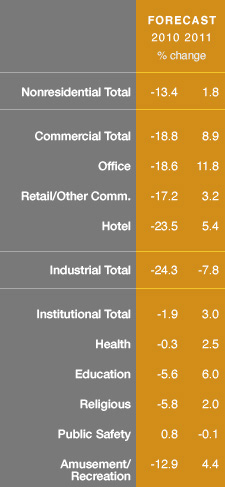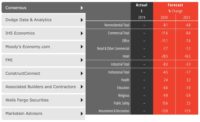|
Despite noting that “the long-awaited recovery seems to be under way,” the AIA's newly released Consensus Construction Forecast offers little reason for optimism in 2010. It does, however, provide hope for 2011.
The semi-annual report—compiled from data provided by McGraw-Hill Construction, Global Insight, Portland Cement Association, MoodysEconomy.com, and other sources—predicts that nonresidential construction activity will fall another 13.4 percent in inflation-adjusted dollars this year, which is notably better than the 20 percent drop-off in 2009. In the report, nonresidential construction refers to the commercial, industrial, and institutional sectors.
Commercial and industrial are projected to be weaker this year than in 2009, with declines of about 20 percent. Office construction spending will dip 18.6 percent, and hotel construction spending will plummet 23.5 percent, according to the study.
On a brighter note, the report anticipates advances in 2011. Nonresidential construction activity is expected to rise 1.8 percent, with the commercial sector to increase 8.9 percent, led by a 11.8 percent hike in office construction spending. However, industrial will still lag; after an anticipated drop of 24.3 percent this year, the industrial sector will fall another 7.8 percent in 2011, according to the report.
“We'll finally see something modestly in the black in 2011," says AIA Chief Economist Kermit Baker, of the industry in general. Architects, typically engaged nine to 12 months in advance of construction, will be among the first in the A/E/C community to benefit from the economic uptick, Baker indicates.
As might be expected, the institutional sector continues to be somewhat of a stalwart during this Great Recession. Institutional spending is expected to drop only 2 percent this year and will increase 3 percent in 2011, due in large part to the American Recovery and Reinvestment Act.
Baker says $30 billion to $35 billion in federal stimulus funds will be spent over the next three years, part of which will go toward retrofitting buildings to make them more energy-efficient. Companies with existing relationships with the U.S. General Services Administration likely will fare the best, he says.
Nevertheless, architects are seeing bottlenecks in the allocation of stimulus money. "We all were hoping that stimulus funds would make a dent in the work, but the money so far has gone predominantly into infrastructure, such as roads, bridges and transit systems, which are primarily done by engineers," says Kirsten Sibilia, chief marketing officer with JCJ Architecture, based in Hartford, Connecticut.
Civic projects are holding up for the firm, but within the hospitality sector, most of JCJ’s on-the-board projects are additions to spas and restaurants, "and those dollars are minimal," explains Sibilia.
Scott Butler, program director for science and technology with HDR CUH2A, in Princeton, New Jersey, foresees a boost in the educational sector, primarily in new university research facilities, courtesy of $1 billion in stimulus money to be distributed by the National Institutes of Health.
“We're seeing stuff in the pipeline starting again," Butler says, "and some clients are seeing credit easing. Also, construction costs are significantly lower, which may prompt people to say, 'Damn it, if we're going to build this building, let's do it now.' "
Read more economic news in our special section, Recession & Recovery.





Post a comment to this article
Report Abusive Comment